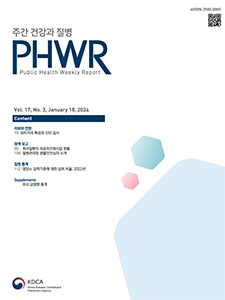Current Issue
Vol.17 No.3, January 18, 2024
-
Review & Perspective 2024-01-18
 0
0
 635
635
 126
126
Characteristics and Diagnostic Tests of Melioidosis
Gyu-Lee Kim, So-Hyeon Kim, Hwajung Yi, Yoon-Seok Chung
Public Health Weekly Report 2024; 17(3): 75-89 https://doi.org/10.56786/PHWR.2024.17.3.1AbstractBurkholderia pseudomallei is a resilient environmental pathogen and an etiological agent of melioidosis causing major morbidity in tropical area in the world, especially in Southeast Asia and Northern Australia. Since no pathognomonic symptom exists for melioidosis, clinical diagnosis can be challenging and routine laboratory tests in clinical laboratories frequently result in misdiagnosis. Several immunological and molecular assays have been developed to improve the efficient detection of the pathogen. Despite these developments, laboratory diagnosis remains complex, and delays in treatment due to misdiagnosis often increase mortality rates. Here, we have reviewed basic characteristics of B. pseudomallei and melioidosis, examining epidemiology, risk factors, laboratory diagnosis, and treatment to provide a broad knowledge base regarding this pathogen and disease. Increasing awareness of this disease should enhance our ability to provide early confirmation of diagnosis and develop a vaccine or novel therapy.
-
Policy Notes 2024-01-18
 0
0
 258
258
 128
128
National Fundholding System for Rare Disease in the Republic of Korea
Hye-Won Jang, Jiwon M. Lee
Public Health Weekly Report 2024; 17(3): 90-103 https://doi.org/10.56786/PHWR.2024.17.3.2 Abstract
AbstractA rare disease is one for which the prevalence population is less than 20,000 or is unknown owing to difficult diagnosis. Furthermore, it refers to a disease designated and announced in accordance with Article 2 of the Enforcement Rule of the Rare Disease Control Act. The ‘National Fundholding System for Rare Disease’ (the National System) targets health insurance subscribers registered under the ‘ Special Case for Rare Disease Calculation.’ Considering the economic burden of patients with rare diseases, recipients are selected through income and property investigations. The income standard for children and adolescents with rare diseases was expanded in 2023 from less than 120% of the standard median income to less than 130%. Furthermore, insurance for children and adolescents with rare diseases has been strengthened. Meanwhile, in 2022, super-expensive rare disease treatments were covered. In such situation, the financial burden of local governments receiving the support for the treatment is being caused. In addition, there is request that the standards for income and property for the selection of beneficiaries of the National System have to be eased. There is also a demand for streamlining the submission of income and property investigation documents. The Division of Rare Disease Management of the Korea Disease Control and Prevention Agency will review ways to secure the continuity and financial soundness of the National System in the future. Plans are underway to improve the income and property standards and support system.
-
Policy Notes 2024-01-18
 0
0
 301
301
 158
158
Introduction of Bio-Safety Review in Korea Disease Control and Prevention Agency
Sang-Yoon Choi, Da-Won Ma, Jeonghwa Shin, Haeng-Seop Shin
Public Health Weekly Report 2024; 17(3): 104-111 https://doi.org/10.56786/PHWR.2024.17.3.3 Abstract
AbstractThe Korea Disease Control and Prevention Agency (KDCA) is responsible for biosafety reviews conducted by the Institutional Biosafety Committee (IBC) to ensure biosecurity in research involving gene recombination or the handling of infectious pathogens (including high-risk pathogens) based on the 「Guidelines for Gene Recombination Experiments」. The KDCA is responsible for biosafety reviews conducted by the IBC to ensure biosecurity in research involving gene recombination or the handling of infectious pathogens (including high-risk pathogens) based on the 「Guidelines for Gene Recombination Experiments」.
-
QuickStats 2024-01-18
 0
0
 161
161
 129
129
Ratio of Nutrient Intake to Dietary Reference Intakes by Nutrient, 2022
Public Health Weekly Report 2024; 17(3): 112-113 https://doi.org/10.56786/PHWR.2024.17.3.4

pp. 1~2097
Most Keyword
?
What is Most Keyword?
- It is the most frequently used keyword in articles in this journal for the past two years.
Most Read
-
Waterborne and Foodborne Disease Outbreaks in the Republic of Korea, 2023
Myung-Jae Hwang, So Yeon Park, Hyungjun Kim, Se Jeong Yang, Sungchan Yang, Jin Seon Yang
Public Health Weekly Report 2025;18: 17-32 https://doi.org/10.56786/PHWR.2025.18.1.2 -
Implementation Plan for the Coronavirus Disease 2019 Vaccination for the 2024–2025 Season: Recommendations of the 6th Expert Committee on Immunization Practices
Hyewook Hwang, Wookeon Lee, Seohyeon Ahn, Young-Sook Choi, Seunghyun Lewis Kwon, Dongwoo Lee, Eun Hwa Choi, SokGoo Lee
Public Health Weekly Report 2025;18: 90-102 https://doi.org/10.56786/PHWR.2025.18.2.3
Editorial Office
+82-43-719-7569





 Full Text
Full Text Cite
Cite


